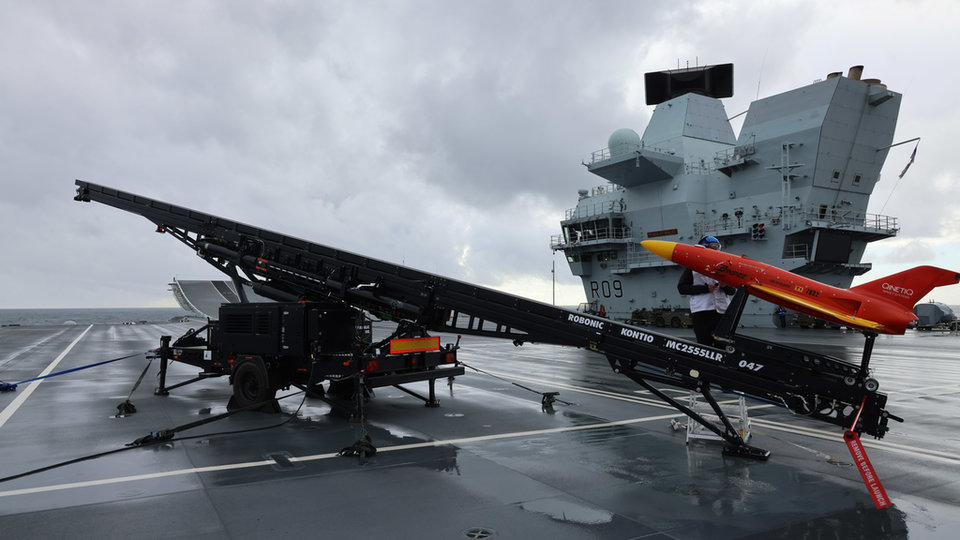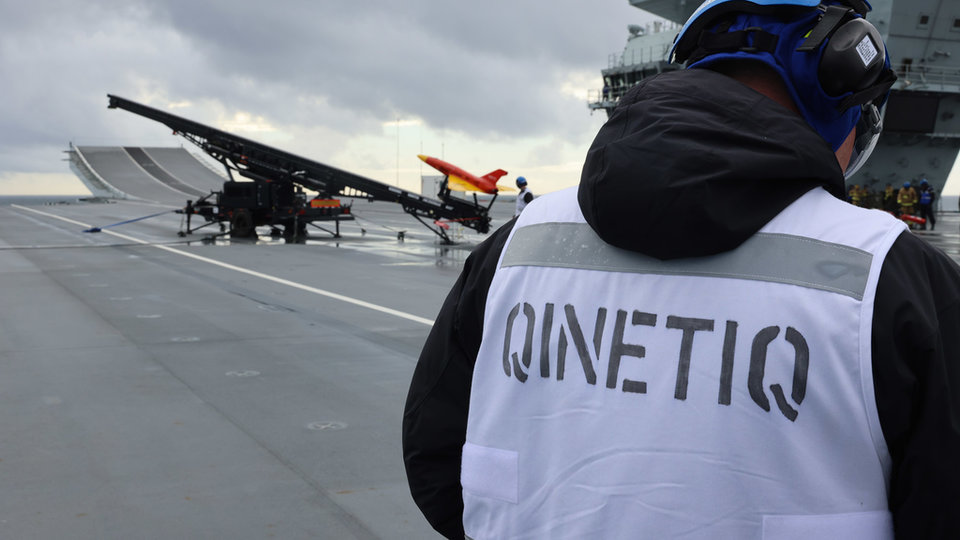UAV
Red air dare: QinetiQ’s Banshee demonstration for Royal Navy
In November, QinetiQ carried out a training demonstration for the UK Royal Navy, launching its Banshee Jet80+ aerial target from the deck of aircraft carrier HMS Prince of Wales for the first time. Berenice Healey finds out how it will help crew members train for real-world scenarios by engaging realistic threat targets while deployed.
Engaging enemy aircraft is one of the most challenging tasks crew members aboard an aircraft carrier can undertake, so it is important to make training for such an event as realistic as possible.
Last February, the Royal Navy (RN) approached QinetiQ with a proposal for a proof of concept trial for delivering a fixed-wing uncrewed aerial vehicle (UAV) to be launched from an RN platform. QinetiQ has a long-term partnering agreement (LTPA) with the UK Ministry of Defence (MOD) to provide experimentation, test, evaluation and training support.
The requirement set out that they should be able to fly fast and undertake complicated manoeuvres as would happen in a real “red air” event, meaning when hostile aircraft are in the immediate vicinity. The programme falls under the RN’s Future Maritime Aviation Force (FMAF) vision.
QinetiQ principal systems engineer Edward Timpson says: “They approached QinetiQ because we have that integration SQEP [Suitably Qualified and Experienced Person] expertise. It was a really racy timeline as they asked us to deliver this in line with the ship's operational programmes.
“There were two main goals: to show a teaming operation for fixed-wing UAVs – so multiple UAVs in the air at one time – and they also wanted to conduct what we call representative profiles, profiles that you would normally see from an attacking aircraft.
“QinetiQ has been operating the Banshee range of UAVs for a number of years in different iterations, and through the LTPA contract it was a natural fit.”
// Banshee Jet 80+ aerial target launches from the deck of HMS Prince of Wales. Credit: QinetiQ
Joint Warrior
The UAVs selected for the demonstration were QinetiQ’s fixed-wing Banshee Jet 80+, one of a range of target UAVs that spans from slower speed, propeller-driven Whirlwinds up to the transonic next-generation vehicles. They have historically been used for targetry work in missile proving, gunnery and radar tracking, but the latest incarnations have potential as a flexible, payload carrying platform because of their high-speed capabilities.
QinetiQ senior campaign manager James Anderson explains that he had already held discussions with the Royal Navy about how it could use Banshee for three years before the demonstration came about, which was based around the MOD’s Hebrides range.
“The reason to use the Hebrides range and bring the carrier up here was because we can accelerate the programme significantly by using an area where a high-speed unmanned aircraft was already cleared for operations,” he says.
“That gave us a huge leap forward in the safety case. Tie that with the fact that the carrier was up here anyway, for exercise Joint Warrior, and peeling out for a day to do something that could be related to Joint Warrior in the future seemed like an ideal combination.”
Boasting a 2.5m wingspan and weighing in at 100kg, the Banshee is a moderately large, dual jet-powered platform that launches from a pneumatic launcher set up on the aircraft carrier deck. Two were used for the trial to prove the teaming capability.
“There are other aspirations with the Banshee that we may be able to do for them in the future,” says Anderson. “We won't deliver the eventual larger airframe, but we do have a lot of skills to help the navy integrate unmanned systems into the carrier.”

// There are plans to carry out two further Banshee integration exercises next year. Credit: QinetiQ.
Electronic warfare
While there are no contracts in place yet, there are plans to carry out two further Banshee integration exercises next year, over which the QinetiQ team will progressively increase the amount of flying time and the complexity of the flying, as well as making the aircraft a more realistic target.
The fact we've got we've got all the ability to do all the clearances, we are the design authority, and it is all ITAR free makes a big difference.
“You need some sort of electronic warfare capabilities to make it look like it's got radar, make it look like it's trying to jam them,” says Anderson.
“Integrating those is something we’ve already done on the Banshee up here in the Hebrides. We want to do that while flying off the carrier.”
The demonstrations received positive feedback from the FMAF team, not least in terms of the rapid turnaround of the product and the clearances necessary to fly Banshee off the carrier in that time. The rate of future progress will be limited by how FMAF funding is prioritised, but Banshee has a number of factors in its favour.
“Another reason they chose the Banshee is because it's a very cost-effective solution compared with most of the competition out there, for the same performance,” explains Anderson.
“It is ITAR [International Traffic in Arms Regulations] free for going on a journey with the RN as it modernises. The fact that we've got the ability to do all the clearances, we are the design authority, and it is all ITAR free makes a big difference. That will really help as we start to move forward, adding things like the electronic warfare pods, keeping them very much to UK technology that we have control over.”
Timpson adds that the airframe is resilient but as it is cost-effective it offers an attritable value to the customer.
“It’s a nice thing for the navy to be able to say that it's designed and built in the UK to be operated by the UK military. It may not be all things to all people but it's certainly beating a path to developing a new capability,” Timpson concludes.

// Wight Ocean and C-2i submitted an amphibious crawler to the competition. Credit: Wight Ocean
// Main image: View of HMS Prince of Wales from a QinetiQ Banshee Jet80+ aerial target. Credit: QinetiQ.